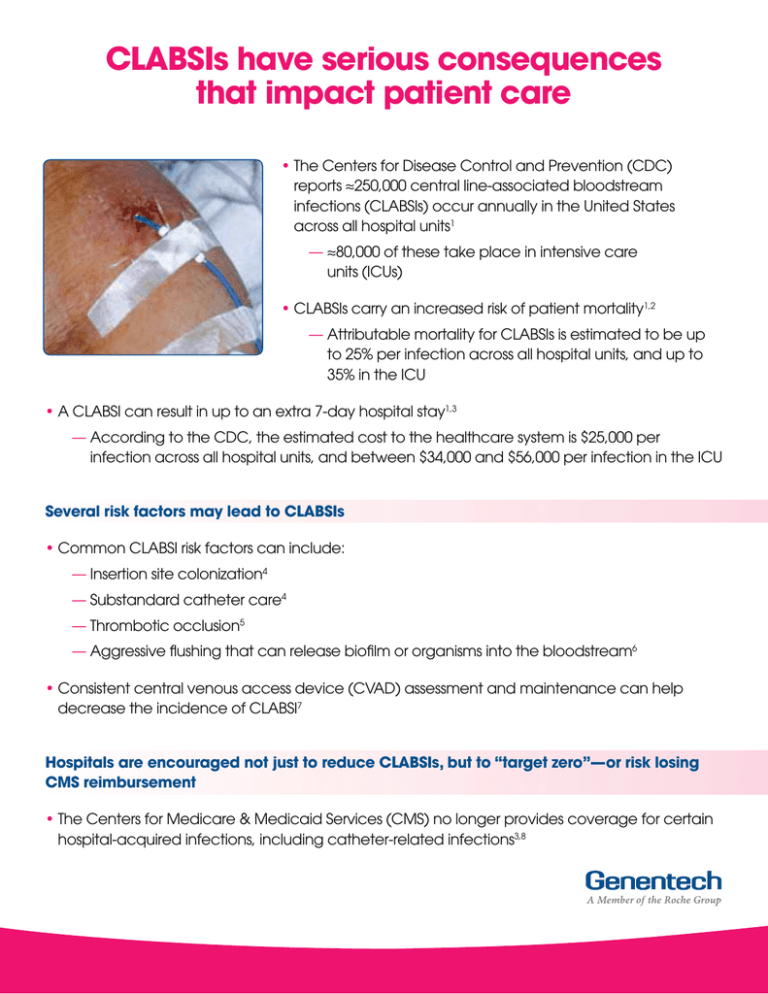
CLABSIs have serious consequences
that impact patient care
• The Centers for Disease Control and Prevention (CDC)
reports ≈250,000 central line-associated bloodstream
infections (CLABSIs) occur annually in the United States
across all hospital units1
— ≈80,000 of these take place in intensive care
units (ICUs)
• CLABSIs carry an increased risk of patient mortality1,2
— Attributable mortality for CLABSIs is estimated to be up
to 25% per infection across all hospital units, and up to
35% in the ICU
• A CLABSI can result in up to an extra 7-day hospital stay1,3
— According to the CDC, the estimated cost to the healthcare system is $25,000 per
infection across all hospital units, and between $34,000 and $56,000 per infection in the ICU
Several risk factors may lead to CLABSIs
• Common CLABSI risk factors can include:
— Insertion site colonization4
— Substandard catheter care4
— Thrombotic occlusion5
— Aggressive flushing that can release biofilm or organisms into the bloodstream6
• Consistent central venous access device (CVAD) assessment and maintenance can help
decrease the incidence of CLABSI7
Hospitals are encouraged not just to reduce CLABSIs, but to “target zero”—or risk losing
CMS reimbursement
• The Centers for Medicare & Medicaid Services (CMS) no longer provides coverage for certain
hospital-acquired infections, including catheter-related infections3,8
The Joint Commission recommends
implementing good catheter management
strategies to help prevent CLABSIs
• According to The Joint Commission National Patient Safety Goal (NPSG) 7, hospitals should
reduce the risk of healthcare-associated infections9
• This includes the requirement to implement evidence-based practices to help prevent CLABSIs9
— Covers short- and long-term CVADs, including peripherally inserted central catheter
(PICC) lines
Elements of Performance for NPSG.07.04.019
1. Educate staff and licensed independent practitioners who are involved in managing
CVADs about CLABSIs and the importance of prevention. Education occurs upon
hire, annually thereafter, and when involvement in these procedures is added to an
individual’s job responsibilities. [Scoring category C]
2. Prior to insertion of a CVAD, educate patients and, as needed, their families about
CLABSI prevention. [Scoring category C]
3. Implement policies and practices aimed at reducing the risk of CLABSIs. These policies
and practices meet regulatory requirements and are aligned with evidence-based
standards (for example, the CDC and/or professional organization guidelines).
[Scoring category C]
4. Conduct periodic risk assessments for CLABSIs, monitor compliance with evidence-based
practices, and evaluate the effectiveness of prevention efforts. [Scoring category A]
5. Provide CLABSI rate data and prevention outcome measures to key stakeholders,
including leaders, licensed independent practitioners, nursing staff, and other clinicians.
[Scoring category A]
6. Use a catheter checklist and a standardized protocol for CVAD insertion.
[Documentation required; scoring category C]
Scoring category A relates to the presence or absence of the requirement and is scored as either yes or no.
Scoring category C is frequency based and requires totaling the number of occurrences. It is scored based
on the number of times your hospital does not meet the requirement.
Along with The Joint Commission and CMS, the Institute for
Healthcare Improvement and the CDC request hospitals
implement evidence-based strategies to help reduce morbidity
and mortality associated with certain hospital-acquired conditions.10
7. Perform hand hygiene prior to catheter insertion or manipulation. [Scoring category C]
8. For adult patients, do not insert catheters into the femoral vein unless other sites are
unavailable. [Scoring category C]
9. Use a standardized supply cart or kit that contains all necessary components for the
insertion of CVADs. [Scoring category C]
10. Use a standardized protocol for sterile barrier precautions during CVAD insertion.
[Scoring category C]
11. Use an antiseptic for skin preparation during CVAD insertion that is cited in scientific
literature or endorsed by professional organizations.* [Scoring category C]
12. Use a standardized protocol to disinfect catheter hubs and injection ports before
accessing the ports. [Documentation required; scoring category C]
13. Evaluate all CVADs routinely and remove nonessential catheters. [Scoring category C]
*This means that the practice used must be validated by an authoritative source. The authoritative source may be
a study published in a peer-reviewed journal that clearly demonstrates the efficacy of that practice or endorsement
of the practice by a professional organization(s) and/or a government agency(ies). It is not acceptable to follow a
practice that is not supported by evidence or widespread consensus.
Strategies to help your organization
reduce CLABSIs and associated
morbidity and mortality
Strategy
Recommended by
Implement evidence-based guidelines 4,9,11,12
− The Joint Commission
− Infusion Nurses Society
− Society for Healthcare Epidemiology of America (SHEA)
− Infectious Diseases Society of America (IDSA)
− Institute for Healthcare Improvement (IHI)
Ensure clinicians receive catheter management
education at least once a year1,4,9
− The Joint Commission
− CDC
− SHEA
− IDSA
Use a catheter checklist and a standardized
protocol for CVAD maintenance1,4
− CDC
− SHEA
− IDSA
Employ well-organized programs focused on
early assessment and CVAD management1,4
− CDC
− SHEA
− IDSA
Keep setting lower and lower goals12
− IHI
Investigate each failure and learn from it12
− IHI
Hold everyone accountable12
− IHI
Celebrate success12
− IHI
References: 1. O’Grady NP, Alexander M, Dellinger EP, et al. Centers for Disease Control and Prevention. Guidelines for the prevention
of intravascular catheter-related infections. MMWR Recomm Rep. 2002;51(RR-10):1-29. 2. Implement the Central Line Bundle. Institute for
Healthcare Improvement Web site. http://www.ihi.org/IHI/Topics/CriticalCare/IntensiveCare/Changes/ImplementtheCentralLineBundle.htm. Accessed
July 8, 2010. 3. Millennium Research Group. US Markets for Vascular Access Devices. 2009. 4. Marschall J, Mermel LA, Classen D, et al. Strategies
to prevent central line-associated bloodstream infections in acute care hospitals. Infect Control Hosp Epidemiol. 2008;29(suppl 1): S22-S30.
5. Wingerter L. Vascular access device thrombosis. Clin J Oncol Nurs. 2003;7(3):345-348. 6. Hadaway LC. Reopen the pipeline for IV therapy.
Nursing. 2005;35(8):54-61. 7. Camp-Sorrell D. State of the science of oncology vascular access devices. Semin Oncol Nurs. 2010;26(2):80-87.
8. Eliminating Serious, Preventable, and Costly Medical Errors—Never Events. Centers for Medicare & Medicaid Services Web site.
http://www.cms.gov/apps/media/press/factsheet.asp?Counter=1863. Accessed July 15, 2010. 9. The Joint Commission on Accreditation
of Healthcare Organizations. National Patient Safety Goals. January 2011. 10. Nakazawa N. Infectious and thrombotic complications of
central venous catheters. Semin Oncol Nurs. 2010;26(2):121-131. 11. Infusion Nurses Society. Infusion nursing standards of practice. J Infus Nurs.
2006;29(suppl 1):S1-S92. 12. What Zero Looks Like: Eliminating Hospital-Acquired Infections. Institute for Healthcare Improvement Web site.
http://www.ihi.org/IHI/Topics/CriticalCare/IntensiveCare/ImprovementStories/WhatZeroLooksLikeEliminatingHospitalAcquiredInfections.htm.
Accessed July 8, 2010.
© 2011 Genentech USA, Inc. All rights reserved. CAT0000237800 Printed in USA.

